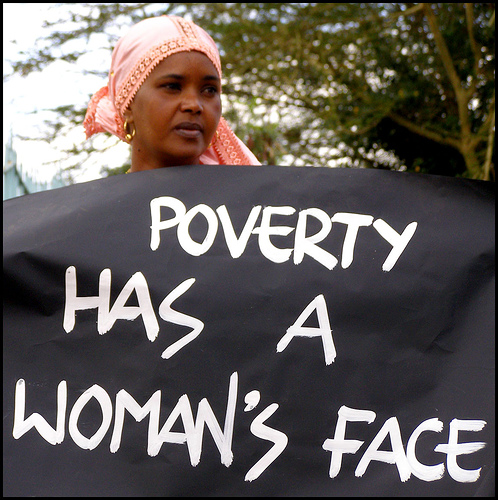Don't forget to submit an entry to the Second Annual Star of Davida Essay Contest!
I recently discovered that January is National Poverty in America Awareness Month. I’m saddened that I didn’t know this beforehand. This sounds like the type of awareness campaign the feminist community would rally behind. Well, even if it's not a terribly well-known campaign month, that doesn't detract from its extreme importance.
I recently discovered that January is National Poverty in America Awareness Month. I’m saddened that I didn’t know this beforehand. This sounds like the type of awareness campaign the feminist community would rally behind. Well, even if it's not a terribly well-known campaign month, that doesn't detract from its extreme importance.
Poverty is very much a women’s issue, to the point that it has become known as the feminization of poverty.
Both the number and percentage of women in poverty is higher than those of men,
and the American poverty gender gap is wider than any other Western country.
This trend is static over all ethnic groups.
Why are women so much poorer than
men? One reason is because of the wage gap. Compared to the white man’s dollar, Asian-American women make 88 cents, white
women make 82 cents, African-American women make 70 cents, and Latinas make a
mere 61 cents. According to straight facts, women simply have less access to
money than men do, and are therefore more likely to be poor.
Part of the reason why the wage gap
is so wide is because women tend to work in lower-paying fields. Almost half of all women in the labor force work within only 20 occupational
categories, whose median annual salary is barely $27,000. This makes sense,
considering that approximately two-thirds of minimum wage workers are women. A woman paid minimum wage ($7.25
an hour) who has two children is left significantly below the poverty line,
unable to adequately provide for herself and her family.
An interesting, but often
ignored, reason for the feminization of poverty is women’s likelihood toprovide unpaid caregiving. Women tend to take care of elderly or disabled
family members more often than men do; in fact, they make up over two-thirds of
unpaid caregivers. When I was at the NOW conference last June, I heard JaniceLynch Schuster speak about this topic at a plenary session. I have definitely
seen this trend in action; my aunt and mother took care of my grandmother for
several years before her death, my best friend’s grandmother cares for her
husband with Alzheimer’s, my mother’s female boss only has minimal assistance
from her brothers when it comes to caring for their aged mother, a family
friend of ours has been providing care for her mother for years, etc. I can’t
actually think of a single man I personally know who serves as the primary care
for a parent or spouse.
So how do we change this horrible
state of affairs? How can we curtail the prevalence of poverty, especially
because of its disproportionate affect on women?
We need to petition our
representatives and all politicians to pass bills that will ensure equality in
the workplace, help women gain access to quality education, and provide
nationally-funded child and elder. Equal pay means fewer women below the
poverty line. More education means more high-quality, higher-paying job
opportunities. Federal child and elder care means fewer home responsibilities
for women and more women in the workforce, lifting themselves up and out of
poverty. It means a better, more equitable America for men and women alike.

You’re linked, twice. Keep up the good writing.
ReplyDeleteTalia, I got a response to this post from JDub on my blog. Hop on over and check out the conversaton.
ReplyDelete